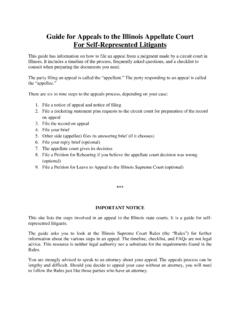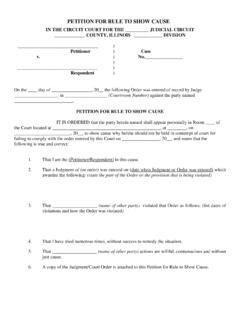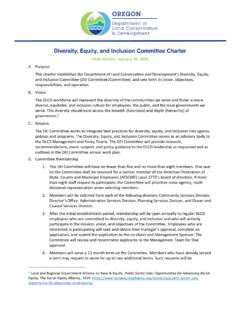Transcription of Bylaws Fact Sheet - Illinois Legal Aid
1 The Law Project is a project of the Chicago Lawyers Committee for Civil Rights Under Law, Inc. 100 N. LaSalle St., Ste. 600 Jody Adler, Director, Chicago, IL 60602 Phone: 312-939-3638 Angie Hall, Staff Attorney Fax: 312-630-1127 Web: Erica Spangler Raz, Staff Attorney For more information, Molly Brooks, Outreach Coordinator contact our office. Bylaws FACT Sheet An organization incorporated under the Illinois General Not for Profit Corporation Act of 1986 should have Bylaws . Organizations that are not corporations may have Bylaws and choose to have them because they establish guidance and clarity for the decision-makers. Bylaws contain the rules and procedures governing how the board of directors operates. They cover the individual's relationship as a Director, officer or member to the organization. They establish who has the power to make certain decisions and they set forth the process that must be followed in making those decisions. Well-drafted Bylaws dictate how disputes are resolved.
2 They do not address issues of the day-to-day activities of the organization. You will find many different samples of Bylaws in books, on the Internet and from other nonprofit organizations. To operate smoothly and efficiently an organization s Bylaws should meet the specific needs of that organization and be in compliance with the state law governing the organization. Start with a simple set of Bylaws , review them every few years and amend them as the organization grows. Discuss the following issues with the directors on your board and work together to decide how your board will address each issue. These decisions will guide the drafting of a set of Bylaws for your organization s needs whether you draft them yourself or consult an attorney. ISSUES ADDRESSED BEFORE DRAFTING Bylaws DIRECTORS 1. How many directors will be on the board? The Illinois statute requires a minimum of three directors on the board. You may specify a range of directors but the largest number may not exceed the smaller by more than five.
3 For example, the Bylaws may provide that there can be a range of three to eight directors to be determined at each annual board meeting, but there cannot be a range of three to fifteen directors. 2. How will the directors be elected? In a nonmember organization, the directors nominate and elect subsequent directors, thus making a self-perpetuating board. In a member organization, the members may elect the directors at the annual meeting. Before drafting Bylaws , you need to determine whether the organization will be a member or nonmember organization. See below for information about membership organizations. 3. What will the directors term limits be? The Law Project is a project of the Chicago Lawyers Committee for Civil Rights Under Law, Inc. The term is the amount of time the directors will serve on the board. There is no statutory guidance for term limits but many organizations find that a one-year term is too short and that a term greater than three years may be too long. The Bylaws may provide that a director may serve for more than one term.
4 Many organizations favor electing directors with staggered terms. With staggered terms all the directors are elected at the same time but the initial board will have directors serving for different time periods. For example, in the first year the organization is in existence, let s say 2007, A and B are elected to serve until 2008, while C, D, and E are elected to serve until 2009. Thereafter all directors serve two-year terms. In 2008, A and B are replaced with F and G who will serve until 2010 (a two-year term). In 2009, C, D, and E are replaced by directors who will serve until 2011 (also a two-year term). The staggered terms enable the board to have some experienced directors at all times, while bringing new perspectives and energy into the board. 4. If there are restrictions on who can be a director, what are they? Some organizations want to make sure there is a specific number of directors from a particular community or another organization. These restrictions are established in the Bylaws .
5 While youth organizations often want youth representation on the board, minors should not serve on the board. Directors have Legal responsibilities to the organization and minors are not legally permitted to take on those responsibilities. The Legal age of majority in Illinois is eighteen. However minors can sit on an advisory committee of the board. 5. When can a director be removed? Directors may be removed by the people who elected them, with or without cause. MEETINGS 1. How often will the directors meet? The statute only requires that there be one meeting a year but a board that only meets once a year will not be an effective board. The board often meets more frequently when it is getting started. Many boards meet on a monthly, bimonthly or quarterly basis. 2. How many directors will be required to call a special meeting? Special meetings are called when a board decision must be addressed and there is no meeting scheduled in a timely basis. The Bylaws should explain who may call the special meeting.
6 By statute, special meetings may be called by the president or the full board of directors. The Bylaws should establish a specific number of the directors, less than the full board, who may also call a special meeting. You don t want this number to be too high because frequently the purpose of a special meeting is to address something that has arisen that must be dealt with quickly. If you need your full board to call the special meeting, it may take too long to coordinate the meeting quickly. 3. How many days and what type of advance notice is required? Under Illinois law, the organization must provide notice of the meeting between five and sixty days prior to any meeting. Notice may be by regular mail, fax, electronic mail, and telephonic notice. 4. What is the quorum? To transact business there must be a quorum at the board meeting. A quorum is the minimum number of directors required to make enforceable decisions and is specified in the Bylaws . If the number of directors at a meeting is less than the quorum, the board cannot make binding decisions.
7 A quorum is usually a majority of the directors. However, the law requires only that a quorum consist of at least 1/3 of the directors then in office. The Law Project is a project of the Chicago Lawyers Committee for Civil Rights Under Law, Inc. OFFICERS The officers on the board are usually called the President, Vice-President, Secretary and Treasurer but you may call them by any other titles. They have specific responsibilities that are defined in the Bylaws . One person may serve in two officer positions at the same time. The same person should not be the President and Vice President or the President and Secretary. If you are uncertain about the difference between a director, an officer and an employee, please visit 1. What are the titles of the board officers? Corporate secretary (required under Illinois law), chairperson, president, treasurer, and one or more vice-presidents. 2. Who will elect the officers? Generally officers are elected by the directors at the annual Board meeting.
8 See below for information about elections in a membership organization. 3. What are the terms for the officer positions? There is no statutory guidance for term limits but many organizations find that a one year term is too short and that a term greater than three years may be too long. 4. Under what circumstances can an officer are removed? Officers may be removed by the people who elected them, with or without cause. MISCELLANEOUS 1. The fiscal year is _____. The fiscal year is the twelve-month accounting period for the organization. It may be the calendar year, running from January 1 until December 31. Or it may be October 1 until September 30, or any other twelve-month period. The due dates for filing annual reports with the IRS and the Illinois Attorney General are based upon the last day of the fiscal year. The Law Project is a project of the Chicago Lawyers Committee for Civil Rights Under Law, Inc. QUESTIONS FOR MEMBERSHIP ORGANIZATIONS THE DIFFERENCE BETWEEN MEMBERS AND DIRECTORS The Board of Directors is responsible for the management of the organization.
9 The Board makes the major decisions about how the organization will operate. The people on the board are the directors and the officers. Sometimes the directors are called members but this does not mean the organization is a membership organization. In a membership organization, the members have special rights and privileges that are established in the Bylaws . The members may have voting rights and may elect the board of directors. In a nonmember organization, new directors are elected or appointed by existing directors. It is important to understand the difference. A nonprofit organization may decide to be a membership organization because members help provide a source of funding through membership dues or the members ability to raise funds for the organization and reflect a broad base of support for the organization. Members may be part of the decision-making process of the group and have voting rights or, they may have special privileges but no voting rights, such as museum or theater memberships.
10 If members have voting rights, the control of the organization lies within its membership. Decision making is prolonged because a majority of the members must come to agreement. Block clubs and groups that work to assist a particular industry or profession are frequently member organizations. Other examples of member organizations are museums and chambers of commerce. Nonprofit corporations that provide direct services to a large segment of the population tend not to be member organizations. If the organization will become a membership organization before drafting Bylaws , it should make decisions about the following issues. 1. Will members pay dues? a. How will the amount of dues be determined? b. How often will dues be paid? Annually, quarterly, semi-annually? c. Will members be removed for failure to pay dues? 2. Will members nominate and elect the directors? 3. How many members will be required to be present to transact business? The statute allows a minimum of 10% of the members.












